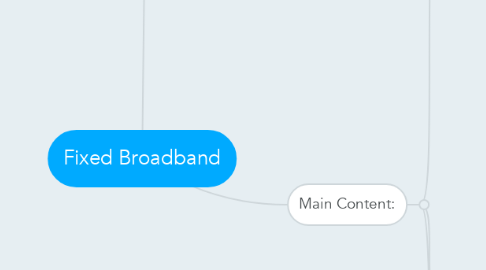
1. Historical Note
1.1. Demand Increase: data communication
1.2. Problems
1.2.1. Computer conn from home: too slow
1.2.2. New infrastructure: expensive
1.3. Solution: Infrastructure adaption
1.3.1. higher bandwidth for data communication
1.3.2. Example: T1- E1: limitation: distance
1.3.3. Path loss per km as a function of operating frequency
2. Main Content:
2.1. DSL: Digital Subscriber Line
2.1.1. 1. uses higher portion of available channel for transmission over a channel 2. Architecture& Sys equip: splitter, DSLAM
2.1.1.1. Feature: Low pass channel
2.1.1.1.1. Because? 1. higher frequency: higher path loss 2. interference: AM radio, cross-talk
2.1.1.1.2. Cross talk: FEXT important than NEXT Because if they jump from upstream to downstream, as they are using different frequency it will not matter a lot; But if they jump from a downstream to downstream, the frequencies used is the same then will really interfere;
2.1.2. Frequency
2.1.2.1. small upstream& big downstream: why? equipment at co has more power; so can endure more path loss
2.1.3. Modulation: DMT (Discrete Multi-Tone)
2.1.3.1. sub-carriers of 4kHz bdwidth
2.1.3.2. Adaptive operation: 1. channel loss high then realize low capacity; 2. one carrier affected by noise then abandon 3. diff carrier frequency, diff modulation
2.1.4. Advances
2.1.4.1. (Asymmetric) ADSL: 1. increased capacity: up to 6.1 Mbit/sec 2. Far from CO - low power - low S/N -low transmission rate 3. Multile QAM when channel condition good
2.1.4.1.1. ADSL2, ADSL2+, ADSL2++
2.1.4.1.2. Yahoo BB
2.1.4.2. VDSL
2.1.4.2.1. Vector VDSL: calculate interference amount & remove it
2.1.4.2.2. more bandwidth - 12MHz
2.2. Co-Axial Cables
2.2.1. 1. Better conducting capability: lower loss per distance& wider bandwidth 2. Structure: Central distribution center, distrib hub, home 3. Long distance communication
2.2.2. Frequency: 6 MHz per slots for each channel, 200 kHz to 6.8 MHz per slot
2.2.3. Modulation: Downstream: TDM Upstream: CSMA
2.2.3.1. Time Division Multiplexing: put signals in one modulator in time domain
2.2.3.2. Carrier Sense Multiple Access: centrally controlled, case station to allocate free resources when several users access same resource
2.2.4. Comcast
2.3. Optic Fibre
2.3.1. 1. glass or plastic fibre to guide light along its length 2. energy remains in fibre, path loss low; loss caused by impurities within glass 3. light wavelength determine signal loss over distance
2.3.2. Modulation
2.3.2.1. Wavelength Division Multiplexing: same resource (wavelength), but different streams of traffic
2.3.2.2. Time Division Multiple Access: scheduling through center office, in the downstream we transmit; in the upstream, we raise our hands and say we have a data packets; first time to send? little package, random access
2.3.3. App: undersea cables
2.3.3.1. 1. low loss- less repeater 2. capacity: so large, no limit 3. too much infras investment, overcapacity
2.3.4. System configurations: FTTN, FTTC, FTTP
2.3.4.1. TBP
2.3.4.1.1. FTTP: faster, high quality, low path loss, future proof, political decision: economically better in the long run?
2.3.4.1.2. FTTN: connection easier, cheaper
2.3.4.1.3. FTTN: connection easier,
